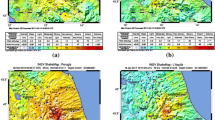Abstract
Safety assessment of damaged school buildings is one of the challenging tasks after damaging earthquakes. In this study, a new post-earthquake safety assessment method is proposed for school buildings. The method enables researchers to evaluate the level of risk and to judge the safety of the school building by taking into account the observed level of structural and non-structural damage. First, the vulnerability of the building is identified by considering the relevant damage indicators. Subsequently, the likely consequences of the various performance levels of the school building are identified. The likelihood of a specific consequence is evaluated by jointly considering all failure mechanisms that can lead to the considered consequence. Critical decisions regarding the school are made based on the level of risk and the available resources for risk mitigation. The methodology is expected to be a useful supporting tool for the post-earthquake decision-making process. Using the proposed method, critical decisions, such as continued use, strengthening or decommissioning school buildings can be handled in a rational and consistent way.
Access this chapter
Tax calculation will be finalised at checkout
Purchases are for personal use only
Similar content being viewed by others
References
Aslani H, Miranda E (2005) Probability-based seismic response analysis. Eng Struct 27:1151–1163. doi:10.1016/j.engstruct.2005.02.015
Cornell CA (1968) Engineering seismic risk analysis. Bull Seismol Soc Am 58:1583–1606
Cornell CA, Krawinkler H (2000) Progress and challenges in seismic performance assessment. PEER Center News. http://peer.berkeley.edu/news/2000spring/index.html. Accessed 15 Sept 2012
Gülkan P (2004) Obstacles to improving seismic safety of school buildings in Turkey. In: Yelland H, Tucker B (eds) Keeping schools safe in earthquakes. OECD, Paris
Gür T, Pay AC, Ramirez JA, Sözen MA, Johnson AM, İrfanoğlu A, Bobet A (2009) Performance of school buildings in Turkey during the 1999 Düzce and the 2003 Bingöl earthquakes. Earthq Spectra 25:239–256
Konstantinidis D, Makris A (2009) Experimental and analytical studies on the response of freestanding laboratory equipment to earthquake shaking. Earthq Eng Struct Dyn 38:827–848. doi:10.1002/eqe.871
Kunnath SK (2007) Application of the PEER PBEE methodology to the I-880 viaduct. PEER 2006/10, Pacific Earthquake Engineering Research Center, University of California, Berkeley
Turkish Earthquake Code (1975) Specification for structures to be built in disaster areas. Ministry of Public Works and Settlement, Government of Republic of Turkey, Ankara
Turkish Earthquake Code (1998) Specification for structures to be built in disaster areas. Ministry of Public Works and Settlement, Government of Republic of Turkey, Ankara
Turkish Earthquake Code (2007) Specification for structures to be built in disaster areas. Ministry of Public Works and Settlement, Government of Republic of Turkey, Ankara
Yazgan U, Dazio A (2012) Post-earthquake damage assessment using residual displacements. Earthq Eng Struct Dyn 41:1257–1276. doi:10.1002/eqe.1184
Yüzügüllü Ö, Barbarosoglu G, Erdik M (2004) Seismic risk mitigation practices of school buildings in Istanbul. In: Yelland H, Tucker B (eds) Keeping schools safe in earthquakes. OECD, Paris
Acknowledgments
The authors acknowledge the devoted educators in Van who guided the authors in the region after the 2011 earthquake disaster for their helpful support. In addition, the support provided by the Ministry of Education and Istanbul Technical University, which enabled the authors to observe the post-earthquake states of the affected schools, is acknowledged.
Author information
Authors and Affiliations
Corresponding author
Editor information
Editors and Affiliations
Rights and permissions
Copyright information
© 2014 Springer International Publishing Switzerland
About this chapter
Cite this chapter
Yazgan, U., Oyguç, R.A. (2014). Post-Earthquake Risk-Based Decision Making Methodology for Turkish School Buildings. In: Ilki, A., Fardis, M. (eds) Seismic Evaluation and Rehabilitation of Structures. Geotechnical, Geological and Earthquake Engineering, vol 26. Springer, Cham. https://doi.org/10.1007/978-3-319-00458-7_3
Download citation
DOI: https://doi.org/10.1007/978-3-319-00458-7_3
Published:
Publisher Name: Springer, Cham
Print ISBN: 978-3-319-00457-0
Online ISBN: 978-3-319-00458-7
eBook Packages: Earth and Environmental ScienceEarth and Environmental Science (R0)




